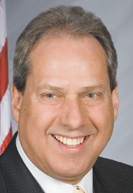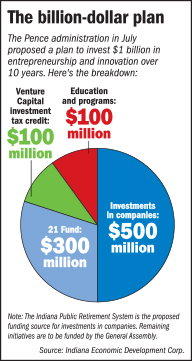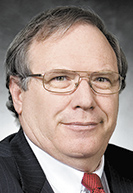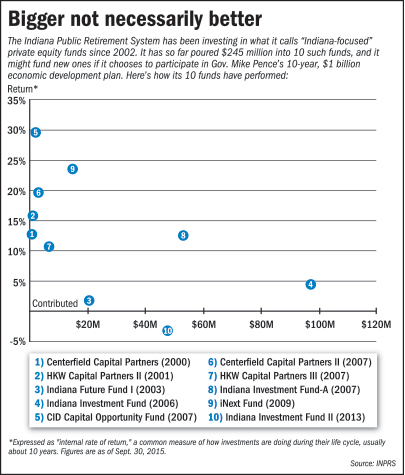Subscriber Benefit
As a subscriber you can listen to articles at work, in the car, or while you work out. Subscribe NowEditor's note: This story has been revised to correct the spelling of Indiana Public Retirement System Executive Director Steve Russo's name.
Indiana’s public pension system over the next several months will start to mull its participation in a $1 billion economic-development initiative proposed by outgoing Republican Gov. Mike Pence—a plan with elements similar to existing pension programs that have yielded mixed results thus far.
In mid-July, Pence announced a plan to invest $1 billion in Indiana “innovation and entrepreneurship” over 10 years. One pillar of the effort involves pumping $500 million of growth capital into early-stage and mid-market Hoosier companies. The governor wants all $500 million to come from the Indiana Public Retirement System, which has$25 billion in investable assets.
 Holcomb
HolcombIt wasn’t an out-of-the-blue request for INPRS, which has poured $245 million into what it calls Indiana-focused private equity funds since 2002.
But those investments have produced annualized returns of only about 7 percent, lagging the returns of other key asset classes—a performance that raises questions about whether the state should be upping the ante. In addition to wanting INPRS to invest larger sums, Pence wants all the money to flow into companies with Indiana operations. Existing Indiana-focused funds have greater latitude, and some of their investments have no Indiana connections.
Pence’s billion-dollar plan has other elements, but the INPRS component is the largest. As the nine-person INPRS board starts to weigh how well the pension system’s investing goals align with Pence’s request, it will be doing so amid a debate about whether it should even entertain such gubernatorial requests.
 Boots
Boots“It would be an acceleration if they actually decide to do that,” State Sen. Phil Boots, R-Crawfordsville, said of the system’s investing $500 million over 10 years, “but I still look for their investment people to invest prudently and continue to do what they need to do.”
He added: “I would be disappointed if the board made any changes in their investment strategy simply because the governor made a request.”
There can be tension between prudent investing and limiting investments to a specific state, private equity experts said, as geographic restrictions can hamper the ability of the state’s outside fund managers to maximize returns.
INPRS Executive Director Steve Russo said the pension system’s investing mandates on earlier Indiana-focused funds “were much more specific in the scope,” but over time, “in order to get the return targets that we thought were the better opportunities, but also to support Indiana, we lightened up the scope.”
Pence administration officials referred requests for comment to the Indiana Economic Development Corp., the quasi-governmental agency charged with shepherding Pence’s plan. Spokeswoman Abby Gras said the plan is looking for $500 million in pension money to go to “Indiana companies that are operating here, but there are no stipulations at this point. It’s a request.”
 Turner
TurnerLt. Gov. Eric Holcomb, the Republican gubernatorial candidate vying to succeed Pence, intends to champion the plan if elected. His Democratic opponent, John Gregg, said he’s not looking for any INPRS funding for his 35-point economic development plan.
Asked whether INPRS should invest Indiana-focused pension money exclusively in Hoosier firms, Holcomb said in an email that INPRS needs to maintain its ability to make the right investments for its members. But he noted that “we want there to be such a strong entrepreneurial and innovation climate in Indiana that the best investment opportunities are here.”
Russo said INPRS participation in Pence’s plan would likely take the form of several small funds over time as opposed to a single, large fund.
He told INPRS board members at a Sept. 2 meeting that existing Indiana-focused funds still have capital to deploy, so he doesn’t expect the creation of a new fund anytime soon.
“We don’t anticipate, given the dry powder that we have in our existing funds, any need to establish anything new potentially any sooner than early- to mid-next year, at the very earliest.”
Fund performance
For decades, INPRS and its predecessors had solely invested in bonds, but Hoosier voters approved a referendum in November 1996 to allow investments in publicly traded stocks.
Around the turn of the century, INPRS also began investing in private equity, which involves steering money into private companies. So far, it has invested in about 240 private equity funds, and private equity assets now account for 12 percent, or $3.2 billion, of its portfolio.
INPRS has 10 Indiana-focused funds, which fall under the private equity umbrella. According to INPRS, all have a dual mandate—to provide attractive investment returns and to spur growth and investment in the state of Indiana.
Half the funds are sponsored, or run by an INPRS-appointed fund manager, and those funds invest in companies with Indiana operations or into other private equity funds. The other five are run by Indiana-based private equity firms, which can invest the money where they choose.
The aggregate return for all 10 funds is 7.2 percent annually from September 2002 to September 2015. Comparatively, the private equity segment has returned 11 percent annually over that span.
 Meredith
MeredithINPRS uses an adjusted Russell 3000 stock index as a private equity benchmark; it returned 12.7 percent annually during that same period.
Russo said the Indiana-focused funds have performed well, better than the 6.75 percent annual return target for the entire $24.6 billion INPRS portfolio.
He noted that the funds usually take about 10 years to mature and return cash, so the lackluster paper returns for newer investments—like the negative annualized return for one investment—should not be considered worrisome.
“You’re deploying money early, but you make most of your returns at the end when companies exit,” Russo said. “So your return curve is a J-curve, [meaning] your returns will be smaller in the beginning and will quickly ramp up at the end.”
Many of the individual Indiana-focused funds have generated solid returns, investment experts said, including 29.7 percent for the Indianapolis-based CID Capital Partners Opportunity Fund, which debuted in 2007. In fact, seven of the 10 funds notched double-digit-percentage returns.
The mature investments have produced “very good returns for the risk that they’re taking,” said Greg Hahn, president and chief investment officer at Indianapolis-based Winthrop Capital Management. “They hold up on a national landscape for what private equity would be.”
However, most of those high-yielding funds had only a few million dollars each from INPRS; some had six-figure sums. The Indiana Investment Fund represents the single largest INPRS bet—$97 million—and it has an annualized return of 4.5 percent after debuting in 2006.
Indiana Investment Fund II has an annualized return of -3.2 percent since its so-called vintage year in 2013. INPRS has committed $150 million to the fund and has poured in $48 million so far.
Not exclusively Indiana
While the Indiana-focused funds have returned 7.2 percent annually from 2002 to 2015, INPRS said its investments in stocks have returned 9.5 percent over that same period.
 Swanson
SwansonSome pension experts said INPRS should take such data into account as it considers the future.
“Are the returns that they’ve gotten what they could have gotten if they invested elsewhere?” said Lynn Turner, who sits on Colorado’s state pension fund board and is a former chief accountant for the Securities and Exchange Commission. “Because you’re not investing to invest in Indiana; you’re investing these people’s retirement savings to maximize returns.”
Russo, who leads INPRS, said the agency’s only goal is to fulfill its fiduciary obligation to its members, but he believes it’s a “double win” when it invests in Indiana companies that contribute to Indiana’s economy—since pensions are paid with market returns and tax dollars.
“These companies, when they’re successful, pay more taxes,” Russo said. “And that helps fund the employer side of these members’ benefits.” But the extent to which these Indiana-focused funds have benefited Indiana’s economy is unclear. INPRS said that, through two funds—Indiana Investment Fund and Indiana Investment Fund II—it injected $102.4 million into 17 companies with operations in Indiana.
The remainder of the $245 million might have found its way to some companies with Indiana operations, but INPRS said it does not track such data for the underlying portfolio companies of those other eight funds.
It declined to list the 17 companies it did track, citing confidentiality agreements. Those two funds are among fivemanaged by Washington, D.C.-based Carlyle Group and New York-based AlpInvest U.S. Holdings LLC, which declined to comment for this article.
Russo acknowledged that not all pension money goes to Indiana companies, but he said the money does go through private equity firms that are based in Indiana, including Centerfield Capital Partners and Hammond Kennedy Whitney & Co. Inc.
He also said some funds, like the life-sciences-focused INext, aren’t restricted to Indiana-related investments, but the private equity firms it invests in were expected to visit Indiana and evaluate investments in Indiana companies.
“The intent was to bring national firms to Indiana that would otherwise not spend time in Indiana to source investments,” he said.
Teresa Meredith, president of the Indiana State Teachers Association, said that, regardless of fund performance, it’s inappropriate for politicians to request pension funding for economic development plans.
“Neither the governor nor any elected official should be directing, or asking, INPRS to make particular investments to fund pet projects,” she said.
Bret Swanson, an economic analyst and INPRS board member, said he’s generally in favor of Pence’s plan and believes pension funding “can be an important component.” But he said the narrower INPRS draws its investment mandates, the more difficult it might be for money managers to find the right investments.
Swanson said time will tell whether there are $500 million worth of investment opportunities over the next decade, but he’s optimistic.
“Over the last 15 years, I think it’s fair to say, there have been some challenges to find all the investments that we’d like. But it’s also true that, in recent years, Indiana has seen a real uptick in our technology community and ecosystem.”
He added: “Whether it’s tech or biotech or manufacturing or logistics, I think we’re headed in the right direction.”•
Please enable JavaScript to view this content.
